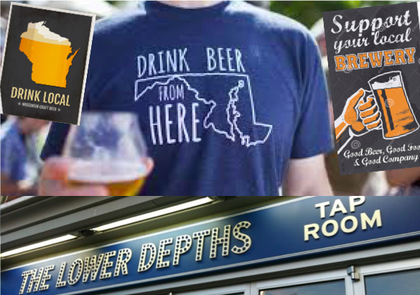Many beer-business observers--the author included--once believed the craft market would shake out resulting in an hourglass shaped structure. On top, substantial volume from the biggest craft players--many bought out in whole or part by BigBeer; at the bottom, substantial volume from a large number of smaller brewers; and crushed in a disappearing middle, financially strapped, failed or failing brewers whose offerings aimed for regional or national scope, but lacked enough traction to acheve sustainable, profitable scale.
Craft growth?
Consider these remarkable recent statistics from Beer Marketers Insights. In 2017, more than 1,000 new craft breweries opened--nearly three a day-- bringing the total to over 6,300 nationwide. While total craft volume continues to grow, albeit at a slower rate, six of the top-ten craft brands--the top of the hourglass-- all lost volume, trending down 5%. (The top-ten account for just under 40% of the total volume, so a 5% drop in a year is a serious amount of volume.) The top is shrinking.
But at the bottom, the microbreweries (some 3,800+ which includes most of the newest breweries) continue to grow their volume by, in aggregate, a stunning 230% over the past five years. Today, according to the Brewers Association as reported in Beer Marketers Insights, small breweries are accounting for virtually all craft-beer volume growth. Continue this, and the inverted pilsner market structure begins to take shape.
Great beer "from around here"
When craft beer disrupted the larger beer market beginning some thirty years ago, the new beers enjoyed three consumer-perceived advantages, none of which BigBeer brands could readily match. First, craft offered new, flavorful beer choices. Second, craft beers came from small, charming breweries where happy artisan brewers seemingly all wore beards, dressed in flannel, and tended copper brew kettles. (These new guys ceaselessly mocked larger brewers as beer factories producing "yellow fizz.") Third, the charming craft breweries were located in distinctive places like Boston, Massachusetts, Chico, California, and Bend, Oregon.
The echo-disruption arises from the rapid growth of local craft beer brands finding success by staying close to home. Most of these breweries' distribution footprints are measured in counties, not states. Eschewing expansion, they've built their financial models based on staying small, not having to raise huge amounts of capital for production facilities, and avoiding the significant cut beer distributors take. Taprooms at micro-breweries (many of which choose not to even package their beers in bottles or cans) and self-distribution dramatically increase profit margins. Local and state governments are happy to see these practices. As an example, in craft-beer-friendly Michigan, liquor licenses which normally have to be bought from an existing holder at great expense, are available at no cost to taprooms and qualifying brewpubs.
Local beer-- with the growing popularity of the locavore and farm-to-table movements adding further momentum-- is becoming the new definition of craft. Indeed, it's already difficult to find a municipality of any appreciable size in the entire country that doesn't have a craft brewery or micro-brewery close by, usually within the city limits. (Think we're over-stating this? Google-search your favorite town's name adding "craft beer" after it.) Most telling, craft drinkers have quickly embraced these small beers as their breweries' gaudy volume-growth demonstrates.
When craft beer first arrived on the scene, it offered something different and special, which meant Budweiser suddenly seemed just too common. In a strikingly similar fashion, the consumer appeal and power of "great beer from around here" is already re-positioning BigCraft as... too common. Risk capital supporting BigCraft may turn out to be a far bigger risk than once imagined. Beer distributors-- reliant as they are on high-volume models-- may also be losers, and even the craft-beer industry associations could fade in influence. Why pay their expensive dues just to sell beer in two counties, especially when government-- where industry associations typically spend most of their effort-- is already all for the idea?
In the last century, the very first disruption in the beer business saw the end of thousands of local breweries which had thrived in the days of immigrant populations, limited refrigeration, and unreliable transportation options. Those local beers--arguably the original craft beers-- faded as national players developed and began to dominate.
In an ironic "back to the future" fashion, prospects may now quickly dim for craft brands that are not... "from around here."





 RSS Feed
RSS Feed
